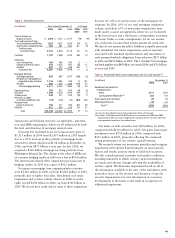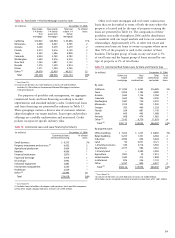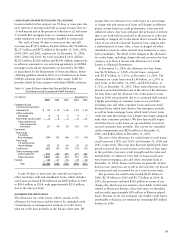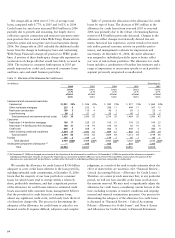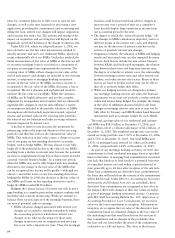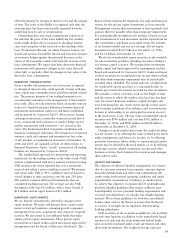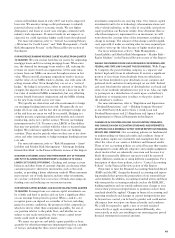Wells Fargo 2006 Annual Report Download - page 56
Download and view the complete annual report
Please find page 56 of the 2006 Wells Fargo annual report below. You can navigate through the pages in the report by either clicking on the pages listed below, or by using the keyword search tool below to find specific information within the annual report.
54
Net charge-offs in 2006 were 0.73% of average total
loans, compared with 0.77% in 2005 and 0.62% in 2004.
Credit losses for auto loans increased $160 million in 2006
partially due to growth and seasoning, but largely due to
collection capacity constraints and restrictive payment exten-
sion practices that occurred when Wells Fargo Financial inte-
grated its prime and non-prime auto loan businesses during
2006. Net charge-offs in 2005 included the additional credit
losses from the change in bankruptcy laws and conforming
Wells Fargo Financial’s charge-off practices to FFIEC guide-
lines. A portion of these bankruptcy charge-offs represent an
acceleration of charge-offs that would have likely occurred in
2006. The increase in consumer bankruptcies in 2005 pri-
marily impacted our credit card, unsecured consumer loans
and lines, auto and small business portfolios.
Table 17 presents the allocation of the allowance for credit
losses by type of loans. The decrease of $93 million in the
allowance for credit losses from year-end 2005 to year-end
2006 was primarily due to the release of remaining Katrina
reserves of $50 million previously discussed. Changes in the
allowance reflect changes in statistically derived loss esti-
mates, historical loss experience, current trends in borrower
risk and/or general economic activity on portfolio perfor-
mance, and management’s estimate for imprecision and
uncertainty. At December 31, 2006, the entire allowance
was assigned to individual portfolio types to better reflect
our view of risk in these portfolios. The allowance for credit
losses includes a combination of baseline loss estimates and a
range of imprecision or uncertainty specific to each portfolio
segment previously categorized as unallocated.
Table 17: Allocation of the Allowance for Credit Losses
(in millions) December 31,
2006 2005 2004 2003 2002
Loans Loans Loans Loans Loans
as % as %as %as %as %
of total of total of total of total of total
loans loans loans loans loans
Commercial and commercial real estate:
Commercial $1,051 22% $ 926 20% $ 940 19% $ 917 19% $ 865 24%
Other real estate mortgage 225 9 253 9 298 11 444 11 307 13
Real estate construction 109 5 115 4 46 3 63 3 53 4
Lease financing 40 2 51 2 30 2 40 2 75 2
Total commercial and commercial real estate 1,425 38 1,345 35 1,314 35 1,464 35 1,300 43
Consumer:
Real estate 1-4 family first mortgage 186 17 229 25 150 31 176 33 104 23
Real estate 1-4 family junior lien mortgage 168 21 118 19 104 18 92 15 62 15
Credit card 606 5 508 4 466 4 443 3 386 4
Other revolving credit and installment 1,434 17 1,060 15 889 11 802 13 597 14
Total consumer 2,394 60 1,915 63 1,609 64 1,513 64 1,149 56
Foreign 145 2 149 2 139 1 95 1 86 1
Total allocated 3,964 100% 3,409 100% 3,062 100% 3,072 100% 2,535 100%
Unallocated component of allowance (1) — 648 888 819 1,284
Total $3,964 $4,057 $3,950 $3,891 $3,819
(1) At December 31, 2006, we changed our estimate of the allocation of the allowance for credit losses. At December 31, 2006, the portion of the allowance assigned to
individual portfolio types includes an amount for imprecision or uncertainty to better reflect our view of risk in these portfolios. In prior years, this portion of the
allowance was associated with the portfolio as a whole, rather than with an individual portfolio type and was categorized as unallocated.
We consider the allowance for credit losses of $3.96 billion
adequate to cover credit losses inherent in the loan portfolio,
including unfunded credit commitments, at December 31, 2006.
Given that the majority of our loan portfolio is consumer
loans, for which losses tend to emerge within a relatively
short, predictable timeframe, and that a significant portion
of the allowance for credit losses relates to estimated credit
losses associated with consumer loans, management believes
that the provision for credit losses for consumer loans,
absent any significant credit event, will closely track the level
of related net charge-offs. The process for determining the
adequacy of the allowance for credit losses is critical to our
financial results. It requires difficult, subjective and complex
judgments, as a result of the need to make estimates about the
effect of matters that are uncertain. (See “Financial Review –
Critical Accounting Policies – Allowance for Credit Losses.”)
Therefore, we cannot provide assurance that, in any particular
period, we will not have sizeable credit losses in relation to
the amount reserved. We may need to significantly adjust the
allowance for credit losses, considering current factors at the
time, including economic or market conditions and ongoing
internal and external examination processes. Our process for
determining the adequacy of the allowance for credit losses
is discussed in “Financial Review – Critical Accounting
Policies – Allowance for Credit Losses” and Note 6 (Loans
and Allowance for Credit Losses) to Financial Statements.



